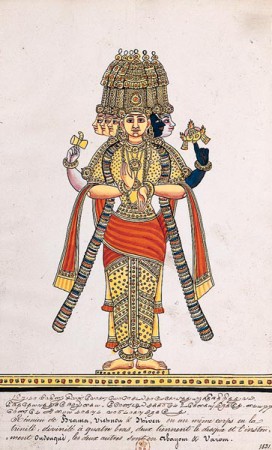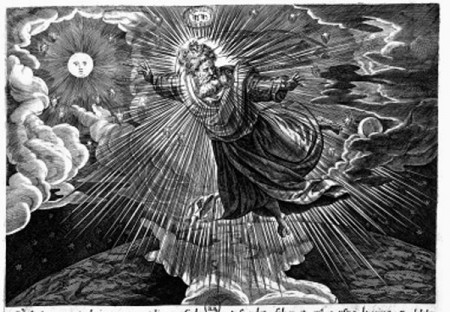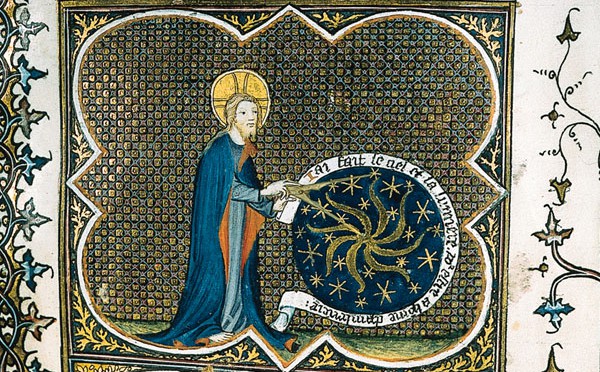Sequel of the preceding post Cosmogenesis (3) : Time and Creation
The Creator
The fundamental theological question about the Creation is: who created the universe? The Christian doctrine of the Holy Trinity asserts that God comprises three Persons: the Father, the Son and the Holy Spirit. Some theologians have regarded God as the first Person of the Trinity, “the omnipotent Father”, Creator of heaven and earth. Others have focused on the image of the “Spirit of God moving upon the face of the waters” and envisaged the Holy Spirit as the Creator. Others again, in an attempt to reconcile these viewpoints, have maintained that the Holy Trinity itself created the world – a reminder of the Vedic belief in a supreme being incarnated as a single body (Trimurti) with three heads: those of Brahma, Vishnu and Siva.

Album of paintings of Indian gods and rulers, 1831. Paintings with captions in Tamil and French. BNF, Manuscripts, Indian 744.
These different theological perspectives are reflected throughout the Middle Ages (in fact right up to the 18th century) in religious art, where one or other interpretation of the Genesis story is illustrated in mosaics, paintings, sculptures, stained glass windows, illuminations and engravings.
The most familiar image of the Creator is the patriarchal figure of the Father (the archetypal example being Michelangelo’s fresco on the ceiling of the Sistine Chapel).

Engraving by Raphael Sadeler, in Thesaurus Historia…, 1585
![Young Christ as Creator. The wonderful fresco adorning the cupola of the baptistery of San Giovanni in Padua is the work of the Florentine artist Giusto Dei Menabuoi, who was active in the second half of the 14th century. It shows God the Son as Creator. Giusto Dei Menabuoi, [The Creation of the World], 14th century.](https://blogs.futura-sciences.com/e-luminet/wp-content/uploads/sites/11/2016/05/Creation-Menabuoi.jpg)
Giusto Dei Menabuoi, [The Creation of the World], 14th century.
As the Holy Spirit the Creator is represented by a dove (the ancient Christian symbol of the Divine Spirit) – in the work of Robert Fludd, for example – or by the Hebrew word “Jehova” surrounded by a symbol of fire (recalling the burning bush from which Moses received the word of God). In a few cases the Creator is shown as a young Christ figure – in the 13th century mosaics of the Basilica of San Marco in Venice and the 14th century frescos of Giusto Dei Menabuoi in Padua, for example. Continue reading Cosmogenesis (4) : The Creator
